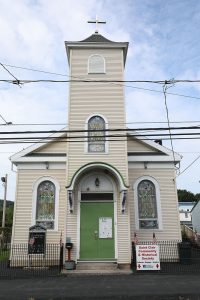To report an AFTERHOURS POWER OUTAGE, please call 570-628-3792
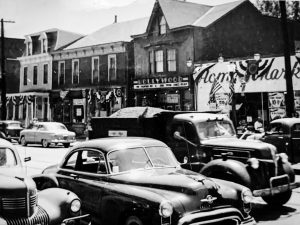
St. Clair is situated north of East Norwegian Township and west of Cass Township. It is in the
heart of what had been for many years an active scene of mining operations. Saint Clair is
about the only borough in Schuylkill County that is relatively flat, being broad and long
surrounded on all sides by mountains.
The beginnings of the borough stretch back to 1808, when the tract was patented by the
Commonwealth to James May, on the 15th of July. Tracts passed through many people until
1830 when a deed dated May 11th, 1830, to Arthur St. Clair Nichols. The deed states the land is
four hundred and two and 3/4 acres, upon which the town of St. Clair has been located and laid
out, either as town lots or otherwise." The name of the town was given in honor of Arthur St.
Clair Nichols. About the year 1835, Col. Francis B. Nichols sold the tract to Messrs. Cary, Hart
and Lee, of Philadelphia, who immediately proceeded to lay out the town with streets, giving
them names, setting up lots for new homes to be built. Up to 1850, the town was known as
Saint Clairville, a village of Norwegian Township.
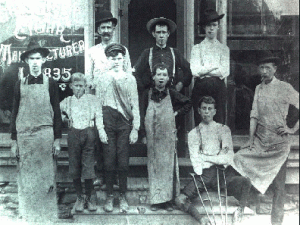
When the town was laid out, there was a saw mill near where the St Clair-Wade Methodist
Church now stands, a grist mill some distance from the saw mill, and another saw mill and
general proximity of what is now in the borough, was worked by Mr. William C. Barber, who lived
but a short distance from the town. Drifts were dug and tested for Anthracite resulting in finding
the Primrose and Mammoth veins. The first coal operation was started in 1830, in an area now
known as Arnout’s Addition and was known as the “Orchard Vien”.
This company, upon the first successful development of the coal beds in the district, built a brick
building, used as a dwelling house and store room, and also a row of miner's houses, which was
intended to accommodate 16 families, eight upon each floor. This was called the "Long Row,"
and was long since arranged for the use of eight families.
In 1829, the first railroad came to St. Clair, it had wooden rails and was drawn by horses. It
extended from St. Clair to Port Carbon. By 1834, the town was growing and the first private
schools were formed. Around 1838, the first free school was opened in the building at the
Borough cemetery which also held religious services. The first teacher was Benjamin Jackson,
who came from Catawissa. By 1845, the first post office was opened and mail was carried by
stagecoach.
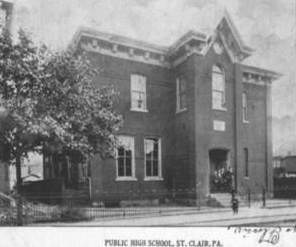
The first settlers in St Clair were natives of Germany and the British Isles (mostly Welsh and
English), natives of Ireland came in the late 1850’s. Natives of Central, southern and eastern
Europe around 1900.
On April 6, 1850, on declaration by Governor Johnson an Act of Incorporation was issued
declaring Saint Clair a borough. The first election in the Borough was held on May 9, 1850
which enabled male residents who have lived in the borough for at least six months the right to
vote for the borough’s government and school board.
The first industry in the borough was lumbering due to the dense forests in the area and a valley
where a large stream of water flowed. The Mill Creek served as a source of energy and means
of transportation. As mining increased the demands for lumber increased and a lumber yard
was built to meet their needs. The first lumberyard, on Nicholas Street between Lawton and
Carroll Streets began in 1845 and lasted until 1925 when it was sold for residential lots. In 1887,
Alfred Mettam, established a lumberyard on North Third street that remains in business today
still owned by the Mettam family.
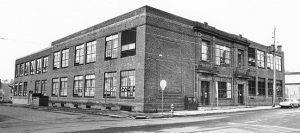
Coal mining began in the borough in 1824, with the discovery of rich coal veins under the entire
borough. The most important of the veins is the Primrose, Mammoth, Orchard, Skidmore,
SevenFoot and Buck Mountain. The discovery of the Mammoth Vein was accidentally
discovered in 1830, by a bank teller Issac Beck, while washing his hands in the creek. Coal
operations surrounded the borough from this time up to the 1960s. The larger collieries that
operated around St. Clair were: Pine Forest, Mt Hope, Pinkerton Drift. St Clair Colliery, Parvins
Colliery, Rainbow Colliery, John’s Eagle Colliery,Hooker Colliery, Hickory Colliery, Sillman
Tunnel, High German Tunnel, Lawton Peacock Colliery, Repplier Coal Company and the St
Clair Coal Company. This list has the major coal operations but there were many other smaller
operations during these years including bootleggers.
In 1868, the Working Man’s Benevolent Association, later to be called United Mine Workers,
was organized in Saint Clair by John Siney. The WBA worked for the rights of miners and fought
for better labor standards.To learn more about the life of John Siney click on this link, for the
Samuel Gomper Papers, University of Maryland website.
To service the miners and their families many businesses popped up around the town. Second
Street was the hub of business with blacksmiths, bakeries, meat, green stores (produce), tailor
shops, hat shops, jewelry, furniture stores, carpet weaving, dairy and ice industry and even
confectionery stores that satisfied everyone's sweet tooth. There were stores for every need.
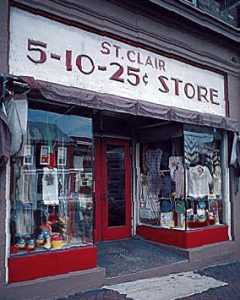
To supply the miners there were two squib (fuse) manufacturing companies one was the Hayes
squib factory and other Daddow & Beadles, “Miner’s Safety Squibs”. Hayes factory was
destroyed in a dramatic fire in 1888 and Daddow & Beadles closed in 1928. S. H. Daddow
opened a miner’s cap factory called the Lattimer Cap Factory on the corner of Nicholas and
Patterson Streets. Mr. Daddow also opened a box factory to produce paper and wood boxes for
the squibs. A shovel manufacturing factory was established on Third street by a Mr. Bowen to
supply the miners.
Over the next hundred or so years St. Clair was home to shirt, dress and pajama factories. In
1875, Peter P. Quirin established the Brass Factory where machinery was made and repaired.
The Quirin family continued with a machine shop business in Saint Clair until the mid 2010’s.
Saint Clair was home to various newspapers since the 1880’s. The first was published by the
Holmes Printing Shop and called “Splinters” and ran to 1913. The Beaumont Printing shop was
a competitor for a little time. The next was the “Saint Clair Bulletin'' until the James Kelly print
shop took over the news in 1925. This soon folded along with another publication called “Our
Town–Saint Clair” in 1928.
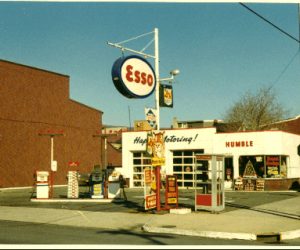
The first fire company in St Clair was formed in 1867, and was called the Hope Hose Company
No. 1. The Columbia Hose Company No. 2, formed in1868.The Alert Fire Company No. 1, in
1883 after petitioning the town for the equipment from the Old Hope Hose Company. The
Rescue Hook and Ladder No. 3 was formed in 1898. The Phoenix Fire Co. No. 4 and
Independent Hose Company No. 1 completed the coverage in the Saint Clair Area.
Patriotism has alway been a pride of Saint Clair’s citizens. During the Civil War the borough
gave the greatest percentage of men in Schuylkill County, including several members of the
“First Defenders' ' who answered the call of President Lincoln. During the Spanish-American
War Saint Clair responded with 105 men. During the “Great War” (WWI) Saint Clair sent 366
men to the armed forces and five women who served as Red Cross nurses. The first county
man to be killed in France was St Clair native, Michael Dudash. During this war 17 made the
supreme sacrifice. A “homecoming” celebration was held on Thanksgiving Day, November 27,
1919. St. Clair native, Joel T. Boone was awarded the Congressional Medal of Honor for his
bravery in France. The picture of this reunion is available to view at the Saint Clair Community
and Historical Society. In WWII, the borough sent 1,500 men and women. Of these, forty-six
never returned home. A “homecoming” celebration and parade was held on July 4, 1946.
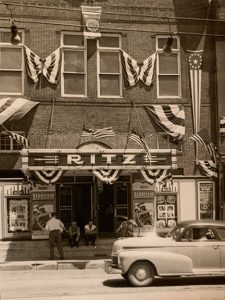
Religion has always been important in the community. The following churches were formed and
are listed in order of their creation and original names; St. Clair Primitive Methodist Church, Holy
Apostles Church, Methodist Episcopal Church, St John’s Reformed and Evangelical
Congregation, St. Boniface German Catholic Church, St. Mary’s Roman Catholic Church, The
Baptist Church, Welsh Baptist Church, St. Michael’s Greek Catholic Russian Orthodox Church,
St. Mary’s Immaculate Conception Church, St. Nicholas Greek Catholic Church, Saint Peter’s
and Paul’s Polish Church, Saint John’s Slovak Lutheran Church, St. Mary’s Russian Orthodox
Church, St. Casimer’s Lithuanian Church, The Slovak Presbyterian Church, and St. John’s
Ukrainian Greek Church. Over the years many of these have closed, combined or changed
their name. The Primitive Methodist Church, formed in 1847, is still in operation along with The
Holy Apostle Church, St. John’s Reformed, The Baptist Church, St. Michael’s Greek Catholic
Russian Orthodox Church, St. Nichols Greek Catholic Church, St. Mary’s Russian Orthodox
Church, The Presbyterian Church, St Mary’s Byzantine Catholic Church and St. Mary’s Roman
Catholic Church is now St. Clare of Assisi Catholic Church.
St. Clair was called home by these notable citizens. John Siney, Dr. Joel T. Boone, Dr. Claude
A. Beck, creator of the first working defibrillator and Congressman Timothy Holden.
Professional sport figures were Jack Titus,Jack Quinn, Eddie Delker, Bob Ryan, Joe Holden,
George Sommers, Ed Shrockman and Lance Rautzman.
For more information on the history of Saint Clair please visit the St Clair Community &
Historical Society web site archive or stop in for a visit. The Historical Society is open on
Saturday and Tuesdays from noon until 3:00 pm and is free to the public. New members are
always welcome and dues are only $5 per year. Keep up to date on our events and fundraisers
by checking out our Facebook page.
